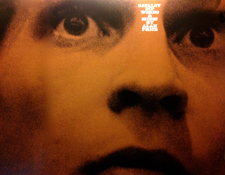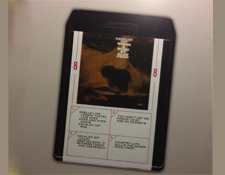It’s the time of year for saving money!
In the world of pop music, there have often been famous — and some infamous — albums that never got released for one reason or another. Some have been pulled from store shelves hours or days after release, going on to become highly sought after collector’s items (such as The Beatles’ so called “butcher cover” incarnation of Yesterday and Today).
One such release came from Alan Price in the mid 1970s…
“Alan who?” you say….
Yeah… I was afraid you’d ask that.
 Alan Price was a founder of the legendary British Invasion rock band The Animals, alongside Eric Burden. After playing haunting organ on tracks like “House of the Rising Sun” and “Don’t Let Me Be Misunderstood,” Price left the band for a solo career. In the mid-60s that found him straddling the lines between pop, rock and cabaret, first with a hit covering Screamin’ Jay Hawkins’ “I Put A Spell On You” and then — for something completely different — with Randy Newman’s “Simon Smith and His Amazing Dancing Bear.” And so went much of Price’s career, careening across styles and genres. In the early 70s he achieved critical acclaim for his soundtrack to the film O Lucky Man! (starring Malcom McDowell).
Alan Price was a founder of the legendary British Invasion rock band The Animals, alongside Eric Burden. After playing haunting organ on tracks like “House of the Rising Sun” and “Don’t Let Me Be Misunderstood,” Price left the band for a solo career. In the mid-60s that found him straddling the lines between pop, rock and cabaret, first with a hit covering Screamin’ Jay Hawkins’ “I Put A Spell On You” and then — for something completely different — with Randy Newman’s “Simon Smith and His Amazing Dancing Bear.” And so went much of Price’s career, careening across styles and genres. In the early 70s he achieved critical acclaim for his soundtrack to the film O Lucky Man! (starring Malcom McDowell).
Price’s initial follow on to that was called Savaloy Dip which — at the 11th hour — was pulled from the market (after some 8-track copies had hit the market — now extremely rare!).
One of the songs on that album, “Between Today And Yesterday” became the basis for a fine like-named album that was ultimately completed and issued in 1974, a recording which encapsulates much of what Price was about up to that time. From the jaunty jolly cabaret pieces such as “Jarrow Song” — which feels like an English twist on Van Dyke Parks and Randy Newman’s takes of Americana — to the New Orleans swing of “In Times Like These” and the haunting “Under the Sun” (would love to hear Bryan Ferry do that one!). Between Today and Yesterday is a fine listen end to end. Its a great album conceptually broken up into the Yesterday side and the Today sides on LP.
And in retrospect, I can kinda see why he (or someone in power) might have decided to pull Savaloy Dip. While that is a fun record with many good songs — songs that Price fans should hear — it is ultimately not as compelling a listen as the eventual Between Today and Yesterday, especially given the time period. Consider the time period when progressive rock bands were issuing highly produced epics (Yes’ Close to the Edge, ELP’s Brain Salad Surgery, etc.), singer-songwriters were putting out career-changing landmarks (Joni Mitchell’s Court & Spark, Paul Simon’s There Goes Rhymin’ Simon Elton John’s Goodbye Yellow Brick Road) and some composers like Pete Townshend and Ray Davies were aggressively tackling near-operatic conceptual works (Quadrophenia, Village Green, etc.).
Also, given that Price had previously issued the now-classic and critically acclaimed soundtrack to O Lucky Man, it stands to reason that someone figured out that Savaloy Dip wasn’t perhaps a big enough successor release.
Thus, one really needs to hear Savaloy Dip in context to fully appreciate the vast conceptual and artistic leap Price made to create its replacement (which did reach #9 in the UK!).
Now, you may be wondering — as I was — as to why Savaloy Dip is being released now? Apparently, its a fairly simple “why not?” situation. The tapes were found and available and apparently in good shape (the CD sounds real nice all things considered). Thus, I applaud Omnivore Records for recognizing that sense of historical importance for the fans.
I like a lot of the songs on Savaloy Dip…
 “Willie The Queen” is an interesting stand out, a sort of sympathetic tale of Gay man at a time when it was just becoming acceptable to sing positively about such topics in mainstream media, a part of society that had been largely pushed aside ; hits by The Kinks (“Lola”) and Lou Reed (“Walk On The Wild Side”) paved the way for this. “Poor Jimmy” is a nice character study of an aging local musician, “a hero, champion and Daddy of them all,” with some lovely horn arrangements. The title track is a nice little rocker reminding me a bit of the flavor of some of The Kinks’ records from this period (which also boasted horn sections).
“Willie The Queen” is an interesting stand out, a sort of sympathetic tale of Gay man at a time when it was just becoming acceptable to sing positively about such topics in mainstream media, a part of society that had been largely pushed aside ; hits by The Kinks (“Lola”) and Lou Reed (“Walk On The Wild Side”) paved the way for this. “Poor Jimmy” is a nice character study of an aging local musician, “a hero, champion and Daddy of them all,” with some lovely horn arrangements. The title track is a nice little rocker reminding me a bit of the flavor of some of The Kinks’ records from this period (which also boasted horn sections).
“Over And Over Again” could be a lost 1968-era Procol Harum song with its whimsical circus organ parts and oom-pah beats by way of a Ray Davies-flavored character study of a lovable loser endlessly getting his bubble burst for “making the same mistakes over and over again…”
Yes, Alan Price fans do need to check out Savaloy Dip. And if you haven’t heard Between Today and Yesterday, you owe it to yourself to track that one down too.
]]>Some other albums by artists which you may or may not realize were at one point lost or almost lost include:
Let it Be by The Beatles was issued after the band split up , but recorded in 1968 before Abbey Road. The rough tapes were gussied up by producer Phil Spector for the initial release but years later Paul McCartney attempted to rectify that history with the release of Let It Be Naked, an album closer to the what The Beatles had envisioned.
Sketches for My Sweetheart The Drunk by Jeff Buckley (issued posthumously)
Velvet Underground 1969 (recorded before Loaded and only issued officially in this form a few years ago via Sundazed Records on their The Velvet Underground :The Verve/MGM Albums boxed set with much of the material appearing on the VU and Another View albums in the mid 1980s
Jethro Tull’s “Chateau d’Isaster” sessions which were aborted, re-written and re-recorded in London to become A Passion Play, re-issued in the recent box set deluxe edition of the album
First Rays of the New Rising Sun was an album Jimi Hendrix was working on when he died but had been issued in wildly variant manners over the years ranging from the good (The Cry Of Love, Rainbow Bridge) to the bad-ugly (Crash Landing, Midnight Lightning, Voodoo Soup). So it was good that in the late ’90s the original recordings were sequenced by original producer Eddie Kramer to create an album that is sequenced as close as we’re bound to get to what Hendrix was envisioning.






